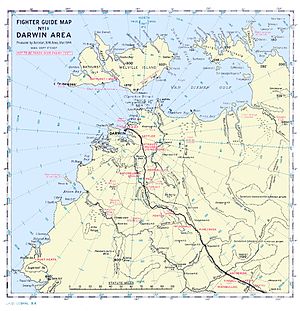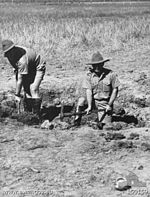Japanese air raids on Australia
Although the main defence was provided by RAAF and Allied fighters, a number of Australian Army anti-aircraft batteries in northern Australia also defended against Japanese air raids.A raid conducted by 54 land-based army bombers later the same day inflicted further damage on the town and RAAF Base Darwin and resulted in the destruction of 20 military aircraft.[4] Japanese naval flying boats conducted four small air raids on the north Queensland city of Townsville and the town of Mossman in late July 1942.The third raid on Townsville occurred in the early hours of 29 July when a single flying boat again attacked the city, dropping seven bombs into the sea and an eighth which fell on an agricultural research station at Oonoonba, damaging a coconut plantation.The fourth raid on north Queensland occurred on the night of 31 July when a single flying boat dropped a bomb which exploded near a house outside of Mossman, injuring a child.





gun cameraMitsubishi G4M2medium bombers753rd Air GroupPacific WarImperial Japanese Navy Air ForceImperial Japanese Army Air ForceAustraliantorpedostrafingfightersfirst and deadliestDarwinRoyal Australian Air ForceAustralian ArmyRoyal Australian NavyUnited States Army Air ForcesUnited States NavyRoyal Air ForceRoyal Netherlands East Indies Air ForceinfrastructureAustralian Army anti-aircraft batteriesnorthern Australiaconquest of the Netherlands East IndiesBombing of DarwinMV NeptunaHMAS DeloraineThe bombing of Darwinaircraft carriersHiryūSōryūTimor SeaRAAF Base DarwinAttack on BroomeWestern Australian emergency of March 1942A6M2 Zeroattacked the town of BroomeWestern AustraliaBroomeJapanese invasion of Javanorth QueenslandTownsvilleMossmanKawanishi H8Kflying boatsP-39 AiracobrasOonoonbaDarwin, Northern TerritoryBathurst IslandCape LondonderryKoolamaKawanishi H6K5Rulhieres BayA6M2 ZerosPK-AFVDouglas DC-3DiamondsWyndhamDarwin RAAF AirfieldHorn Island, QueenslandWolverhamptonStaffordshireLarrakeyahMitsubishi G4MKatherineSattler AirfieldStokes HillVesteysPort HedlandHughes AirfieldNoonamahCox PeninsulaLivingstone AirfieldBatchelor AirfieldPell AirfieldCoomalie Creek AirfieldStrauss AirfieldSupermarine SpitfireHMAS Patricia Cam(10:15) Darwin RAAF Airfield and Darwin Floating Dock, NTcutterHMAS MaroubraExmouth GulfFenton AirfieldLong AirfieldOnslowDrysdale River Mission3rd Air GroupTakao Air GroupNo. 1 Wing RAAFMilitary history of Australia during World War IIBattle for Australia